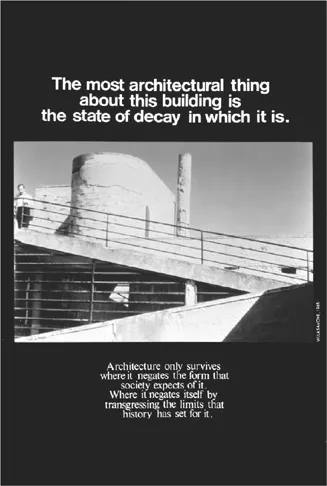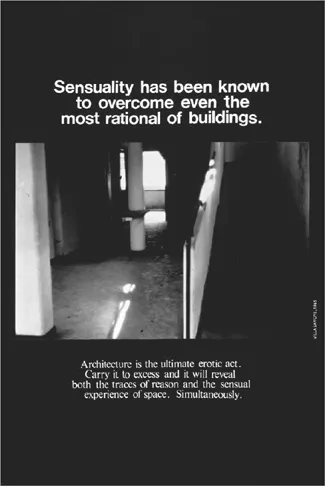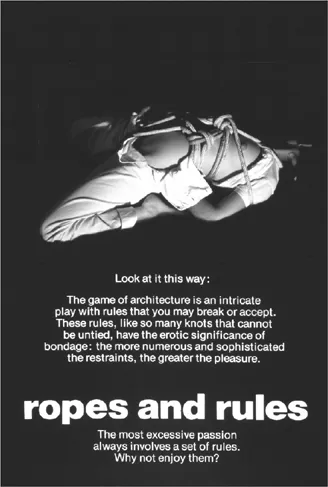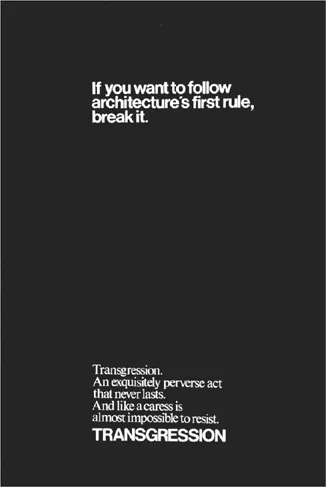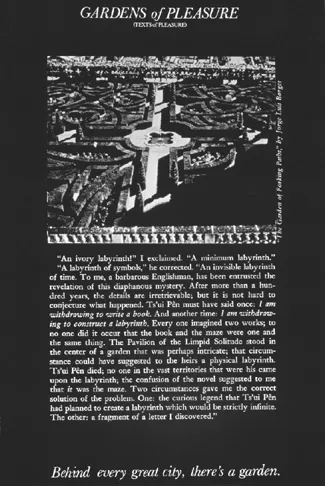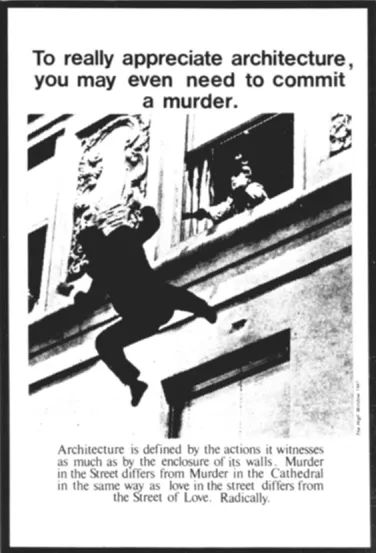Intervention 1
Bernard Tschumi
Transgression is a very big word. It is a word that is derived from literature and philosophy, and also of course rooted in religion and other social frameworks such as the law. What, though, does transgression have to do with architecture? Architecture has a very long history spanning many thousands of years, and over this period architecture has conveyed or adopted a series of ideas which are taken for granted. Architecture has become, therefore, what I would call a ‘dictionary of received ideas’. This will embody a great number of clichés; but when one questions clichés, or received ideas, one must look to see if there are moments of break-down – of where things do not quite fit.
By the late 1960s one of Modernism’s defining buildings, Le Corbusier’s Villa Savoye near Paris, came under threat of demolition, resulting in many young architecture students demonstrating in favour of saving it. I was one of them. When I visited it, something incredible happened; the building was amazing, it was quite astonishing in its state of decay – in its state of complete dereliction from many years of neglect. It occurred to me then that perhaps architecture is not only about perfection and the realisation of an abstract concept; it is also about the sensations of the occupant, including making room for an interaction between building and feelings/body. I therefore began to press for a resolution through which the Villa Savoye could be preserved in the state in which it was at the time. The building stank; it was filled with graffiti; it embodied a very different presence than that conceived by Le Corbusier, and more emotional charge than contemporary design could achieve (Figure I1.1). Amusingly enough, the building came to be completely restored, but the restoration was so pure it was shocking, prompting a programme of de-restoration – restoration with less ‘make-up’.
Figure I1.1
Villa Savoye advertisement: decay
Figure I1.2
Villa Savoye advertisement: sensuality
I quote this example to make the point that architecture is not absolute – it is relative. Architecture is related to other things that happen in it. There is no architecture unless something happens within it. Further, we know that, even for the student, architecture is filled with constraints. These constraints, these rules, these regulations (whether they are city regulations, budgets or other limits) are things we learn to deal with, to play with even. We must learn to make these constraints, dare I say, part of the project. Unless we make these limits pleasurable our lives as architects would be miserable. Much of architecture is a game where one simply takes advantage of the disadvantage; redefining the invisible opponent (the rule; the limit; the constraint) as a positive factor.
The advertisement shown in Figure I1.3 makes an analogy between certain sado-masochistic practices and the constraints facing the architect. In the 1970s I created a set of advertisements, including one depicting the Ville Savoye, for the now-defunct journal Oppositions, although they came to be published more widely. The intention was to demonstrate that architecture is something that belongs to everyone. Architecture is not simply a knowledge of form, it is a form of knowledge, and we share this form of knowledge with others: not only mathematicians and philosophers but anyone we might meet on the street. The advertisements were made to communicate relatively abstract ideas to a larger audience.
Traditionally, architecture’s first rule is: ‘Get the job!’ However, I would argue that the first rule is, in fact, to break it. This sensibility leads the architect to do the unexpected, to surprise the client who arrives with a generic idea which provides a platform for subversion. Architecture is interesting in that it can be defined in terms of budget, square metres and programme; but it is the architect who negotiates these limits, who examines how a person might move through a building, who considers the vectors of movements which can be among the most exciting parts of a project – consider the possibilities inherent in a ramp, a stair or an elevator. Once the architect receives the brief, they should begin asking: ‘how can I twist the programme? … how can I provide extra life? … how can I make it more than it is?’ That is breaking the first rule. And it should be as pleasurable as it can be; one that is impossible to resist.
The writer and surrealist Georges Bataille cast architecture in an interesting light with his dictionary of architecture1 which, of course, began with the letter A. Bataille (1929), however, commenced with the word ‘abattoir – a slaughterhouse’.2 Hardly a conventional way in which to begin a discourse on the subject, but Bataille’s intention was to demonstrate that behind architecture exists a whole system of authority – a hierarchy – a set of disciplines which he considered problematic due to the way they structure society. In particular, Bataille set out to question the metaphors by which language adopts architectural references. In his work The Labyrinth,3 Bataille discussed the strange relationship between the absolute abstraction of the one and the sensations of passing through the other; the world of abstraction versus the world of experience. I have always felt this to be a fascinating observation because it precisely defines the condition of architecture: concept and experience. In considering this further, I came to develop the notion of death as the ultimate abstraction juxtaposed with life as the absolute immediacy of sensation; the boundary between the two, I came to consider, is eroticism. The idea of pleasure; the idea of desire.
Figure I1.3
Ropes and rules advertisement
Figure I1.4
Transgression advertisement
Figure I1.5
Gardens of pleasure advertisement
Figure I1.6
Masks advertisement
Figure I1.7
Murder advertisement
Architecture shares historic links with other disciplines. Consider gardens. The gardens of the Renaissance served as the beginning of cities in the centuries that followed; the avenue of trees established the possibility of a future urban road.
I have always found such inter-disciplinary dialogues to be interesting, especially with regard to the visible and the invisible (the meanings that lie masked). The idea beh...

